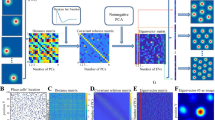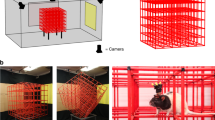Abstract
How the brain encodes spatial information is an important topic. Experimental and theoretical progresses achieved in this area mainly focused on the neuronal response in the lower-dimensional space such as a linear track or a horizontal flat arena. How the real three-dimensional (3-D) space is represented in the brain is unknown. Grid cells in the medial entorhinal cortex and the place cells in the hippocampus are the principal spatial neurons, and the grid cells provide important inputs to the place cells. In order to simulate the place cell activity in higher dimension, we proposed a rotating-integration model to generate the place field on non-horizontal surfaces for crawling animal in 3-D space. By referring to the gravity signal as an anchor, preferred directions of the grid cell will be rotated with the animal’s body plane during navigating on the surfaces. Then, multiple grid cell patterns with distributed orientations and wavelengths are integrated to form the firing field(s) of a place cell. The results can not only account for the known experimental recordings but also predict a segment planar encoding property of place cell on novel complex surfaces. It suggests that the spatial cognition for crawling animal is achieved by a mosaic of lower-dimensional codes rather than the full volumetric perception. This work can help us understand how the spatial information provided by the external physical world is represented and processed by the neuronal systems.




Similar content being viewed by others
Data Availability
The current work has no associated data.
References
Tolman, E.C.: Cognitive maps in rats and men. Psychol. Rev. 55(4), 189–208 (1948). https://doi.org/10.1037/h0061626
O’Keefe, J., Dostrovsky, J.: The hippocampus as a spatial map. Preliminary evidence from unit activity in the freely-moving rat. Brain Res. 34(1), 171–5 (1971). https://doi.org/10.1016/0006-8993(71)90358-1
Park, E., Dvorak, D., Fenton, A.: Ensemble place codes in hippocampus: CA1, CA3, and dentate gyrus place cells have multiple place fields in large environments. PLoS ONE 6(7), e22349 (2011). https://doi.org/10.1371/journal.pone.0022349
Wilson, M.A., McNaughton, B.L.: Dynamics of the hippocampal ensemble code for space. Science 5124(261), 1055–8 (1993). https://doi.org/10.1126/science.8351520
Yates, D.: Place cells as route planners. Nat. Rev. Neurosci. 14(6), 380–381 (2013). https://doi.org/10.1038/nrn3514
Wang, Y., Wang, R., Zhu, Y.: Optimal path-finding through mental exploration based on neural energy field gradients. Cognit. Neurodyn. 11(1), 99–111 (2017). https://doi.org/10.1007/s11571-016-9412-2
Zeng, T., Si, B.: A brain-inspired compact cognitive mapping system. Cognit. Neurodyn. 15, 91–101 (2021). https://doi.org/10.1007/s11571-020-09621-6
Fyhn, M., Molden, S., Moser, E.I., Moser, M.B.: Spatial representation in the entorhinal cortex. Science 305(5688), 1258–1264 (2004)
Hafting, T., Fyhn, M., Molden, S., Moser, M.B., Moser, E.I.: Microstructure of a spatial map in the entorhinal cortex. Nature 436(7052), 801–806 (2005)
Sargolini, F., Fyhn, M., Hafting, T., et al.: Conjunctive representation of position, direction, and velocity in entorhinal cortex. Science 312(5774), 758–62 (2006). https://doi.org/10.1126/science.1125572
Solstad, T., Moser, E.I., Einevoll, G.T.: From grid cells to place cells: a mathematical model. Hippocampus 16, 1026–31 (2006). https://doi.org/10.1002/hipo.20244
Barry, C., Hayman, R., Burgess, N., Jeffery, K.: Experience-dependent rescaling of entorhinal grids. Nat. Neurosci. 10(6), 682–684 (2007)
Hayman, R., Verriotis, M.A., Jovalekic, A., Fenton, A.A., Jeffery, K.J.: Anisotropic encoding of three-dimensional space by place cells and grid cells. Nat. Neurosci. 14(9), 1182–8 (2011). https://doi.org/10.1038/nn.2892
Rowland, D.C., Moser, M.B.: A three-dimensional neural compass. Nature 517(7533), 156–7 (2015). https://doi.org/10.1038/nature14076
Yartsev, M.M., Ulanovsky, N.: Representation of three-dimensional space in the hippocampus of flying bats. Science 340(6130), 367–372 (2013). https://doi.org/10.1126/science.1235338
Wang, Y., Xu, X., Wang, R.: The place cell activity is information-efficient constrained by energy. Neural Netw. 116, 110–118 (2019). https://doi.org/10.1016/j.neunet.2019.04.001
Wang, Y., Wang, R., Xu, X.: Neural energy supply-consumption properties based on Hodgkin-Huxley model. Neural Plast. 2017, 1–11 (2017)
Wang, Y., Xu, X., Zhu, Y., Wang, R.: Neural energy mechanism and neurodynamics of memory transformation. Nonlinear Dyn. 97(1), 697–714 (2019)
Chen, X., Yang, T.: A neural network model of basal ganglia’s decision-making circuitry. Cognit. Neurodyn. 15, 17–26 (2021). https://doi.org/10.1007/s11571-020-09609-2
Tozzi, A., Ahmad, M.Z., Peters, J.F.: Neural computing in four spatial dimensions. Cognit. Neurodyn. 15, 349–357 (2021). https://doi.org/10.1007/s11571-020-09598-2
Riley, S.N., Davies, J.: A spiking neural network model of spatial and visual mental imagery. Cognit. Neurodyn. 14(2), 239–251 (2020). https://doi.org/10.1007/s11571-019-09566-5
Šterk, M., Dolenšek, J., Bombek, L.K., Markovič, R., et al.: Assessing the origin and velocity of Ca2+ waves in three-dimensional tissue: insights from a mathematical model and confocal imaging in mouse pancreas tissue slices. Commun. Nonlinear Sci. Numer. Simul. 93, 105495 (2021). https://doi.org/10.1016/j.cnsns.2020.105495
Gosak, M., Markovič, R., Dolenšek, J., et al.: Network science of biological systems at different scales: a review. Phys. Life Rev. 24, 118–135 (2018). https://doi.org/10.1016/j.plrev.2017.11.003
Cash, S., Yuste, R.: Linear summation of excitatory inputs by CA1 pyramidal neurons. Neuron 22(2), 383–394 (1999). https://doi.org/10.1016/S0896-6273(00)81098-3
Gasparini, S., Jeffrey, C.M.: State-dependent dendritic computation in hippocampal CA1 pyramidal neurons. J. Neurosci. 26(7), 2088–2100 (2006). https://doi.org/10.1523/JNEUROSCI.4428-05.2006
Laurens, J., Kim, B., Dickman, J.D., Angelaki, D.E.: Gravity orientation tuning in macaque anterior thalamus. Nat. Neurosci. 19(12), 1566–1568 (2016). https://doi.org/10.1038/nn.4423
Wang, Y., Xu, X., Pan, X., Wang, R.: Grid cell activity and path integration on 2-D manifolds in 3-D space. Nonlinear Dyn. 104, 1767–1780 (2021). https://doi.org/10.1007/s11071-021-06337-y
Burgess, N., O’Keefe, J.: Models of place and grid cell firing and theta rhythmicity. Current Opinion Neurobiol. 21(5), 734–44 (2011). https://doi.org/10.1016/j.conb.2011.07.002
Casali, G., Bush, D., Jeffery, K.: Altered neural odometry in the vertical dimension. Proceedings of the National Academy of Sciences of the United States of America 116(10), 4631–4636 (2019). https://doi.org/10.1073/pnas.1811867116
Goldstein, H., Poole, C., Safko, J.: Classical Mechanics, 2nd edn. Addison-Wesley, USA (1980)
Hayman, R., Casali, G., Wilson, J.J., Jeffery, K.: Grid cells on steeply sloping terrain: evidence for planar rather than volumetric encoding. Front. Psychol. 6, 925 (2015). https://doi.org/10.3389/fpsyg.2015.00925
Yartsev, M.M., Witter, M.P., Ulanovsky, N.: Grid cells without theta oscillations in the entorhinal cortex of bats. Nature 479(7371), 103–7 (2011). https://doi.org/10.1038/nature10583
Porter, B.S., Schmidt, R., Bilkey, D.K.: Hippocampal place cell encoding of sloping terrain. Hippocampus 28(11), 767–782 (2018). https://doi.org/10.1002/hipo.22966
Wang, Y., Xu, X., Wang, R.: An energy model of place cell network in three dimensional space. Front. Neurosci. 12, 264 (2018). https://doi.org/10.3389/fnins.2018.00264
Laurens, J., Meng, H., Angelaki, D.E.: Neural representation of orientation relative to gravity in the macaque cerebellum. Neuron 80(6), 1508–1518 (2013). https://doi.org/10.1016/j.neuron.2013.09.029
Ravishankar Rao, A.: An oscillatory neural network model that demonstrates the benefits of multisensory learning. Cognit. Neurodyn. 12, 481–99 (2018). https://doi.org/10.1007/s11571-018-9489-x
Wang, Y., Xu, X., Wang, R.: Energy features in spontaneous up and down oscillations. Cognit. Neurodyn. 15, 65–75 (2021). https://doi.org/10.1007/s11571-020-09597-3
Wang, Y., Xu, X., Wang, R.: Modeling the grid cell activity on non-horizontal surfaces based on oscillatory interference modulated by gravity. Neural Netw. 141, 199–210 (2021)
Acknowledgements
We thank the editor and anonymous reviewers for their valuable feedback and insightful advice. We thank the National Natural Science Foundation of China and Natural Science Foundation of Shanghai for supporting this research.
Funding
This work is supported by the National Natural Science Foundation of China (Nos.12172132, 11802095, 11702096, 12072113) and the Natural Science Foundation of Shanghai (No.19zr1473100).
Author information
Authors and Affiliations
Corresponding author
Ethics declarations
Conflict of interest
The authors declare that they have no conflict of interest.
Code availability
The code generated for the current study is available from the corresponding author on reasonable request.
Additional information
Publisher's Note
Springer Nature remains neutral with regard to jurisdictional claims in published maps and institutional affiliations.
Supplementary Information
Below is the link to the electronic supplementary material.
Rights and permissions
About this article
Cite this article
Xu, X., Wang, Y. & Wang, R. The place cell activity in three-dimensional space generated by multiple grid cell inputs. Nonlinear Dyn 108, 1719–1731 (2022). https://doi.org/10.1007/s11071-022-07247-3
Received:
Accepted:
Published:
Issue Date:
DOI: https://doi.org/10.1007/s11071-022-07247-3




